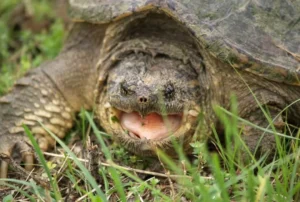Have you ever wondered about the eating habits of snapping turtles and whether they include ducklings in their diet? It’s a fascinating topic which led to the question do snapping turtles eat ducklings?
Yes, snapping turtles are known to occasionally prey on ducklings. While they primarily feed on aquatic vegetation, insects, fish, and carrion, they are opportunistic feeders and will consume small animals such as ducklings if the opportunity arises.
Also, snapping turtles, with their powerful jaws and opportunistic feeding behavior, are known for being formidable predators. But do they actually prey on the vulnerable offspring of ducks? Let’s explore this intriguing question together.
Feeding Behavior and Diet of snapping turtles

Snapping turtles are opportunistic feeders and have a varied diet. Their feeding behavior is largely influenced by their habitat, size, and availability of prey. Here’s an overview of their feeding behavior and diet:
- Carnivorous Diet: Snapping turtles are primarily carnivorous and feed on a wide variety of prey including:
- Fish: They are known to consume various species of fish, especially those found in the waters where they inhabit.
- Amphibians: Frogs, toads, newts, and salamanders are all part of their diet.
- Reptiles: Snapping turtles may consume smaller turtles and reptiles, including snakes and small turtles.
- Invertebrates: They also eat insects, crayfish, snails, and other aquatic invertebrates.
- Small Mammals: Occasionally, snapping turtles may prey on small mammals such as mice or ducklings.
- Scavenging Behavior: Snapping turtles are known scavengers and will feed on carrion or dead animals they come across. They are often attracted to the scent of decaying flesh.
- Opportunistic Feeders: These turtles are opportunistic feeders and will consume whatever prey is available and within reach. They are known to lie in wait for prey to pass by, ambushing them with a quick snap of their powerful jaws.
- Feeding Strategy: Snapping turtles use a sit-and-wait hunting strategy, where they remain motionless in the water, camouflaged among aquatic vegetation or debris, waiting for prey to come within striking distance. When prey comes near, they can quickly extend their necks and snap their powerful jaws shut, capturing the prey.
- Seasonal Variation: Their diet may also vary seasonally. For example, they may feed more heavily on fish during the warmer months when fish are more active, and switch to amphibians or invertebrates during colder months when fish activity decreases.
- Habitat Influence: The habitat in which snapping turtles reside can influence their diet. Those living in freshwater environments may have a diet more focused on aquatic prey, while those in more terrestrial habitats may consume a greater proportion of terrestrial prey.
Overall, snapping turtles are opportunistic predators with a broad diet, capable of adapting to the availability of prey in their environment. They play an important role in maintaining the balance of aquatic ecosystems through their feeding behavior.
Do snapping turtles eat ducklings?
Snapping turtles are opportunistic predators with a varied diet, and unfortunately, yes, they do sometimes prey on ducklings. Here’s a detailed explanation of why and how snapping turtles might prey on ducklings:
- Opportunistic Feeding Behavior: Snapping turtles are known for their opportunistic feeding behavior. They are scavengers and predators, and they will eat whatever food source presents itself. This includes small mammals, fish, insects, amphibians, and sometimes even carrion.
- Habitat Overlap: Snapping turtles and ducklings often share the same habitats, particularly bodies of water like ponds, lakes, streams, and marshes. These areas provide ample food and shelter for both snapping turtles and ducklings, leading to potential interactions between the two.
- Predatory Instincts: Snapping turtles have strong jaws and sharp beaks capable of inflicting serious damage. When encountering small, vulnerable prey like ducklings, snapping turtles may perceive them as easy targets and seize the opportunity to hunt them.
- Vulnerable Prey: Ducklings are particularly vulnerable to predation due to their small size, limited mobility, and lack of defensive capabilities. They often swim close to the water’s surface, making them more accessible to snapping turtles lurking below.
- Hunger and Food Availability: Snapping turtles may also target ducklings when other food sources are scarce or when they are particularly hungry. In such situations, they may resort to preying on whatever is available, including ducklings.
- Feeding Strategy: Snapping turtles are ambush predators, lying in wait for prey to come within striking distance. They may remain submerged in the water, partially buried in mud or vegetation, ready to ambush passing ducklings or other small animals that venture too close.
- Feeding Mechanics: Once a snapping turtle catches a duckling, it will use its powerful jaws to grasp and hold onto the prey. Snapping turtles are not particularly fast swimmers, but they are strong and persistent. They will attempt to overpower their prey and may retreat to the safety of deeper water to consume it.
While snapping turtles do sometimes prey on ducklings, they are just one of many potential predators that pose a threat to young waterfowl. Other predators, such as larger birds of prey, fish, mammals, and even other turtles, may also target ducklings.
This predation is a natural part of the ecosystem and plays a role in regulating populations. However, in areas where duck populations are of concern, efforts may be made to manage snapping turtle populations or implement measures to protect ducklings, such as providing nesting shelters or reducing habitat disturbances.
Snapping Turtles and Ducklings Interaction


